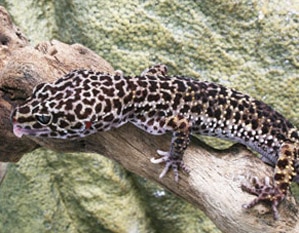One of the world’s largest scorpions, the emperor is also the most widely kept, and captive born specimens are readily available. Other than females with young on their back, emperor scorpions are rather mild-mannered. The sting may be painful, but is not considered dangerous to healthy adults.
Physical Description
 Females may reach 7 inches in length and, when gravid, exceed 50 grams in weight (by way of comparison, the average house mouse weighs 20 grams); males are slightly smaller. Both sexes are jet black in color.
Females may reach 7 inches in length and, when gravid, exceed 50 grams in weight (by way of comparison, the average house mouse weighs 20 grams); males are slightly smaller. Both sexes are jet black in color.
Range and Habitat
Emperor scorpions thrive in areas of high humidity, and are generally associated with rainforests. There are some reports of populations living in wet savannas and human-influenced habitats as well. They are native to northwest and north-central Africa, with their range extending from Mauritania south and east to Zaire.
Status in the Wild
Wild populations have been little-studied, but concern over huge exports in the early 1990’s led to the listing of this species on CITES II. Those in the US trade are largely captive bred, although animals “ranched” in Togo and Benin are sometimes imported. The closely related P. dictator and P. gambiensis, uncommon in the pet trade, are also listed on CITES II.
CAPTIVE HUSBANDRY
The Enclosure
Provide your scorpions with as much space as possible. A pair can be kept in a 10 gallon aquarium, but larger is always better; a 20 gallon can support 4-6 animals. The screen cover should be secured with cage clamps.
Physical Environment – Habitat Type and Terrarium Decorations
Emperor scorpions inhabit extensive burrow systems in the wild, and should be given the opportunity to burrow in captivity. Under such conditions, they will exhibit a wide range of interesting behaviors – far more so than if kept in a simple terrarium. When able to construct secure burrows, captive scorpions become quite confident and therefore more likely to show themselves.
Emperors also take readily to artificial caves and hideouts excavated below driftwood and other structures. I once created a very interesting exhibit by partially burying a number of artificial caves at different levels within the substrate of a 55 gallon aquarium. The resident colony of emperor scorpions dug pathways between the various cave entrances and established a complicated maze of “avenues” – more reminiscent of rodent runways than anything one might associate with an invertebrate. I highly recommend this type of set up for your scorpions.
Substrate
Excavator Clay Burrowing Substrate is specifically designed for fossorial animals and is a great choice for burrowing scorpions. A few handfuls of Jungle Earth Reptile Bedding should be mixed in to help retain moisture.
Click: Emperor Scorpion, Pandinus imperator, Care – Part 2, to read the second part of this article.
 That Reptile Blog – Reptile, Amphibian and Exotic Pet Care and Information
That Reptile Blog – Reptile, Amphibian and Exotic Pet Care and Information

 Writing in the current issue of the journal Animal Behavior, researchers from the University of Grenada report that female Mexican lance-headed rattlesnakes frequently consume infertile eggs and non-living young after giving birth. This is said to be the first documented case of cannibalism among rattlesnakes (please see below for my observations, however). Interestingly, with a sole exception, the females did not consume young that were born alive, even though these remain inactive for several hours after birth, and appear (to us, at least!) to be dead.
Writing in the current issue of the journal Animal Behavior, researchers from the University of Grenada report that female Mexican lance-headed rattlesnakes frequently consume infertile eggs and non-living young after giving birth. This is said to be the first documented case of cannibalism among rattlesnakes (please see below for my observations, however). Interestingly, with a sole exception, the females did not consume young that were born alive, even though these remain inactive for several hours after birth, and appear (to us, at least!) to be dead. I had the wonderful opportunity of participating in the renovation of the Staten Island Zoo’s reptile house, former stomping ground of legendary snakeman Carl Kauffeld (known to all snake keepers as the author of Snakes, the Keeper and the Kept and Snakes and Snake Hunting).
I had the wonderful opportunity of participating in the renovation of the Staten Island Zoo’s reptile house, former stomping ground of legendary snakeman Carl Kauffeld (known to all snake keepers as the author of Snakes, the Keeper and the Kept and Snakes and Snake Hunting). The ever popular leopard gecko is a good choice as an introduction to the breeding of lizards in captivity. Success, while not assured, is common…yet, these little fellows are so captivating that even zoos and well-experienced breeders continue to work with them.
The ever popular leopard gecko is a good choice as an introduction to the breeding of lizards in captivity. Success, while not assured, is common…yet, these little fellows are so captivating that even zoos and well-experienced breeders continue to work with them.